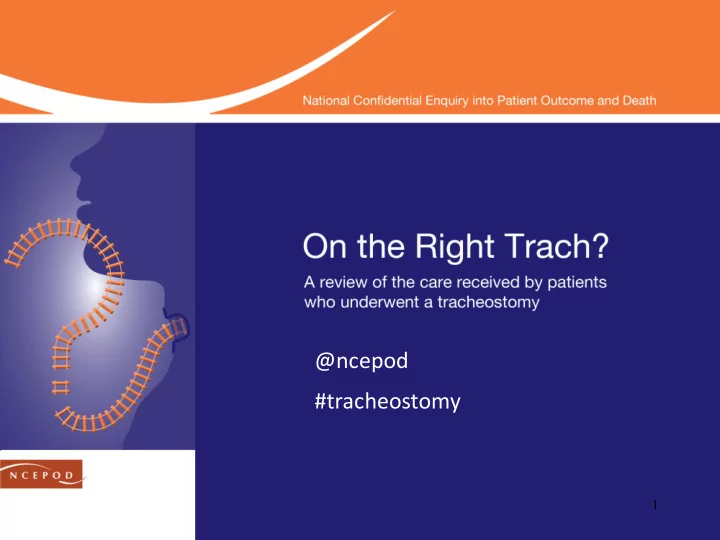

Bedside information • Documentation of routine information on tracheostomy tubes and ongoing care (including cuff pressure monitoring) was not always readily available as part of bedside observations in patients. For example, in 178/396 (45%) of cases there was insufficient data for Advisors to make a decision about cuff pressure when clinical notes were reviewed 71
Key findings • 27% (112/419) of first tubes changes in critical Care occurred less than 7 days after insertion • 50.4% (57/113) tube changes in the first 7 days were unplanned • Only 15/89 patients with a BMI of >30 had a tube in which length could be adjusted at first tube change • 95% (551/580) of critical care patients were discharged with a cuffed tracheostomy tube still in place • In just 53.3% (211/396) of case notes was information available about cuff pressure 72
Recommendations • When changing tracheostomy tubes the correct size and length of tube should be carefully selected according to patient need, and with particular care in patients with a high BMI • Unplanned tube changes pose additional risks and should be reported as critical incidents • At critical care discharge there must be careful consideration as to whether a cuffed tube is required. If a cuff is required competences and equipment must be available to measure cuff pressure • Tracheostomy tube information as well as essential equipment should be readily available at the bedside * 73
The multidisciplinary team and care of tracheostomy patients 74
Number of wards caring for patients 75
Hospital policy for tracheostomy care 76
Tracheostomy leads 77
Clinical teams in the ward MDT 78
Discussion at the ward MDT 79
Patients not discussed at a ward MDT 80
Swallowing difficulty – ward patients 81
Swallowing difficulty – advisor opinion 82
Multidisciplinary audit 83
Key findings • 67.1% (318/474) of ward patients with a tracheostomy were discussed at an MDT meeting • Composition of the MDT on the ward varied with relatively poor representation from Dietetics and Critical care outreach (42.7% and 58.8% of teams respectively) • Swallowing difficulty occurred in 51% (220/425) of ward patients with a tracheostomy • 57% (96/168) of patients with swallowing difficulty on the ward had an early referral to speech and language therapy (SLT) • 26.9% (456/1693) of patients on critical care had input from SLT 84
Recommendations • Multidisciplinary care pathways which provide continuity between critical care unit staff and ward clinicians, and which facilitate decannulation and discharge planning need to be established for all tracheostomy patients* • Involvement of SLT in critical care units needs to be facilitated to provide high quality communication strategies particularly for more complex patients • Swallowing difficulty in tracheostomy patients should be clearly recognised requiring referral to SLT • Swallowing difficulty in tracheostomy patients should be the subject of ongoing study 85
Complications and adverse events 86
Complications in critical care 87
Number of complications per patient 88
Timing of complications in critical care 89
Major complications & consultant input 90
Case study A middle aged patient with a high BMI sustained a high cervical fracture with a high thoracic sensory level due to spinal cord trauma. There were other injuries, to chest & face, and the patient underwent a difficult surgical tracheostomy insertion. At day 10 and during day time hours the tube was either blocked or displaced which resulted in a cardiac arrest responding to a short period of CPR and tube re-insertion. Management was complicated by lack of venous access at this point. Advisors commented on the speed of onset of severe hypoxia and arrest in this patient which was ultimately very well managed by resident staff. Despite the potential for major harm as a result of this complication the patient was successfully decannulated about one month later. 91
Ward complications 92
Long term effects – Advisor opinion 93
Training in blocked & displaced tubes 94
Resuscitation training 95
Bedside capnography – organisational data 96
Key findings • 23.6% of Critical care patients and 31.3% of ward patients in this study experienced defined complications related to their tracheostomy • The most serious complications involved tube displacement, obstruction, pneumothorax and major haemorrhage • Accidental tube displacement was more common in ward based patients (6.3% vs. 4.1%) • 80.6% (174/216) of hospitals had a policy for management of blocked and displaced tubes • 27.9% (48/172) of hospitals did NOT provide training programme for management of blocked and displaced tubes • 71.5% of units used continuous capnography when patients were ventilator dependent 97
Recommendations • Bedside staff caring for tracheostomy patients must be competent to recognise and manage common airway complications including tube obstruction or displacement * • Emergency action plans need to reflect the escalation policy for a difficult airway event in order to summon appropriate senior staff • Training programmes in management of blocked and displaced tubes and difficult tube changes need to be delivered in accordance with existing national guidelines • Core competences for the care of tracheostomy patients including resuscitation should be set out by Trusts using existing national resources • Capnography must be available and used at each bed space whilst a patient is ventilator dependent 98
Outcomes in tracheostomy patients 99
Outcome on critical care 100
Recommend
More recommend